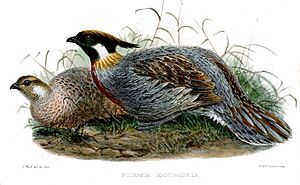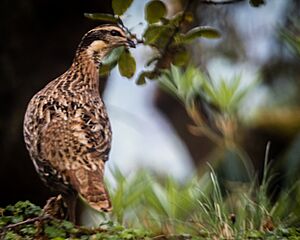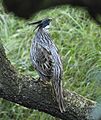Koklass pheasant facts for kids
Quick facts for kids Koklass Pheasant |
|
|---|---|
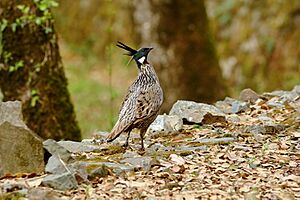 |
|
| Male at Pangot, Uttarakhand, India. | |
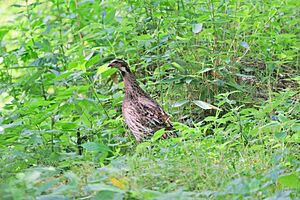 |
|
| Female at Yichang, Hubei, China. | |
| Conservation status | |
| Scientific classification | |
| Genus: |
Pucrasia
|
| Species: |
macrolopha
|
The koklass pheasant (Pucrasia macrolopha) is a type of bird known for its beautiful feathers. It's a "gamebird," which means people sometimes hunt it. These birds are related to grouse and turkeys. They are the only species in their special group, called Pucrasia. Both the names "koklass" and "pucrasia" come from the sound the bird makes when it calls out.
Koklass pheasants are birds that like to live in cold, northern places. They are one of the few gamebirds that can fly uphill easily. They can also fly for many miles without stopping. These birds usually stay with one partner for life. Both the mother and father help raise their young chicks.
For most of the year, koklass pheasants eat plants. Their diet includes pine nuts, pine shoots, bamboo shoots, and seeds. When the weather gets warmer, especially when they are nesting and raising chicks, they eat a lot of insects. During this time, they mostly eat ants. They also eat things like catkins, pollen, and fruit.
Contents
About the Koklass Pheasant
The koklass pheasant is a shy bird that lives in high forests. You can find them from Afghanistan to central Nepal, and in parts of northern and eastern China.
What Koklass Pheasants Look Like
Male koklass pheasants have shiny silver-grey feathers on their upper bodies. Each feather has a velvety-black stripe down the middle. They have a unique black head, a chestnut-colored chest, and bright white patches on the sides of their neck.
Female koklass pheasants look different from the males. Their upper bodies are covered with pale brown feathers. Both male and female koklass pheasants have long tails with pale feathers at the tips.
Male koklass pheasants usually weigh about 1135–1415 grams (around 2.5 to 3.1 pounds). Females are a bit lighter, weighing about 1025–1135 grams (around 2.2 to 2.5 pounds). The males are about 58 to 64 centimeters (23 to 25 inches) long, and the females are about 18 to 22 centimeters (7 to 8.7 inches) long. Young koklass pheasants look like the adult females.
Where They Live and How They Behave
Koklass pheasants do not live above the tree line, which means they stay where trees can grow. They are not as colorful as some other pheasants. Males and females look a bit different, but not extremely so.
Even though they often hide under bushes, making them hard to spot, you can hear them. They make loud calls before dawn during their breeding season and in the autumn. These calls help scientists estimate how many of them are in an area.
Koklass pheasants usually stay in pairs or small family groups all year long. They build their nests on the ground. At night, they sleep by roosting on trees or under rocky overhangs to stay safe.
Different Types of Koklass Pheasants
There are nine different types, or subspecies, of the koklass pheasant. Each one has slight differences in appearance or where they live.
Some of these subspecies include:
- Kashmir koklass pheasant - P. m. biddulphi
- Western koklass pheasant - P. m. castanea
- Indian koklass pheasant - P. m. macrolopha
- Nepal koklass pheasant - P. m. nipalensis
- Yellow-necked koklass pheasant - P. m. xanthospila
One type, P. m. biddulphi, lives from Kashmir to Kullu in India. Other types, like P. m. nipalensis, P. m. castanea, and P. m. macrolopha, are found only on the southern side of the northwest and western Himalaya mountains. The other five types live in China and Mongolia.
Images for kids
-
Pucrasia macrolopha macrolopha Male at Manila, Uttarakhand
-
Pucrasia macrolopha macrolopha Male at Manila, Uttarakhand



